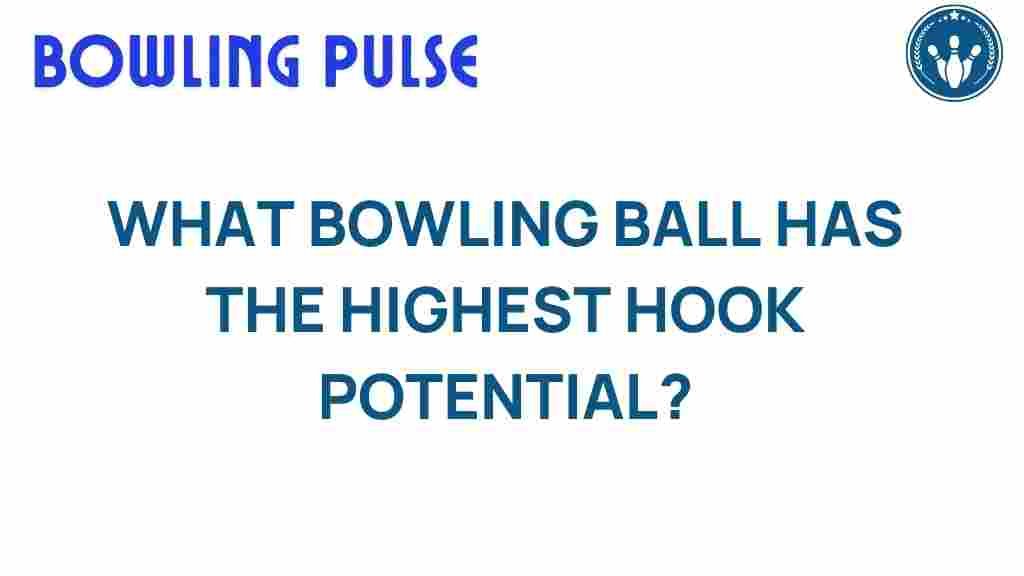Unlocking the Mystery: Which Bowling Ball Hooks the Most?
Bowling is a sport that combines skill, precision, and the right equipment to achieve the best performance on the lanes. One of the most crucial aspects of bowling is understanding how to make your bowling ball hook effectively. This can significantly impact your scoring and overall game strategy. In this article, we will delve into the mystery of which bowling ball hooks the most, focusing on key factors such as hook potential, bowling techniques, equipment, and lane conditions.
Understanding Hook Potential
The term hook potential refers to the ability of a bowling ball to change direction as it travels down the lane. Several factors influence a ball’s hook potential, including its coverstock, core design, and the bowler’s technique. Here’s a closer look at each factor:
1. Coverstock
The coverstock is the outer layer of the bowling ball and plays a crucial role in determining how much the ball will hook. There are three main types of coverstock:
- Plastic: Usually found in entry-level balls, plastic coverstocks produce minimal hook.
- Urethane: Provides a moderate amount of hook and is ideal for medium oil conditions.
- Reactive Resin: This high-performance material is designed to create a significant hook, especially on oily lanes.
2. Core Design
The core of the bowling ball affects its weight distribution and overall dynamics. There are two main types of cores:
- Symmetrical Cores: These cores provide a smooth and predictable hook.
- Asymmetrical Cores: They offer a more aggressive hook and can be adjusted further with drilling techniques.
3. Bowling Techniques
Your personal bowling technique is perhaps the most vital factor in achieving a successful hook. Here are some techniques to consider:
- Grip: The way you grip the ball can affect your release and hook. A proper grip allows for better control and spin.
- Release Point: Timing your release helps in generating the right amount of hook.
- Follow Through: A strong follow-through can enhance the ball’s rotation and hook potential.
Choosing the Right Bowling Ball
When selecting a bowling ball, consider the following:
- Bowler’s Skill Level: Beginners may benefit from a plastic or urethane ball, while experienced bowlers should opt for reactive resin balls.
- Lane Conditions: If you frequently bowl on oily lanes, a ball with higher hook potential is essential.
- Weight: The weight of the ball should match your strength and playing style for optimal performance.
Top Bowling Balls for Hook Potential
Here are some of the best bowling balls known for their exceptional hook potential:
- Storm Phaze II: Known for its aggressive hook on medium to heavy oil lanes.
- Hammer Black Widow 2.0: Offers a strong backend reaction, ideal for experienced bowlers.
- Brunswick Kingpin: Features a unique core design that enhances hook potential significantly.
Bowling Strategy: Maximizing Hook Potential
To maximize your bowling ball’s hook potential, implement these strategies:
1. Adjust Your Grip
Your grip plays a vital role in how much your ball hooks. Experiment with different grip styles, such as:
- Fingertip Grip: Provides more hook and is popular among advanced bowlers.
- Semi-Fingertip Grip: A balance between control and hook for intermediate bowlers.
2. Understand Lane Conditions
Lane conditions can vary significantly, affecting your ball’s performance. Pay attention to:
- Oil Patterns: Some patterns favor a strong hook, while others may require a straighter approach.
- Dry Areas: Bowling balls tend to hook more on dry lanes, so adjust your intention accordingly.
3. Practice Different Releases
Experiment with your release point to find the optimal angle for hooking the ball. Consider:
- Low Release: More speed, less hook.
- High Release: More rotation, more hook.
Troubleshooting Hook Issues
If you’re struggling to achieve the desired hook, consider these troubleshooting tips:
1. Inspect Your Equipment
Check your bowling ball for any signs of wear or damage. A damaged coverstock can affect hook potential significantly.
2. Consult a Pro Shop
Professional bowling shops can provide valuable insights into selecting the right ball and adjusting your grip or drilling.
3. Analyze Your Technique
Record your bowling sessions to analyze your technique. Look for inconsistencies in your release or follow-through.
Scoring and Hook Potential
Understanding how to effectively utilize hook potential can greatly enhance your scoring. Here’s how:
- Strikes: A well-executed hook can lead to more strikes as the ball hits the pins at an optimal angle.
- Spare Conversions: Hook potential can help in converting challenging spares, particularly when targeting corner pins.
Conclusion
In conclusion, unlocking the mystery of which bowling ball hooks the most involves understanding various factors such as hook potential, bowling techniques, and lane conditions. By selecting the right equipment and applying effective bowling strategies, you can significantly improve your performance and scoring. Remember, the right ball combined with proper technique can lead to a successful and enjoyable bowling experience.
For more tips on improving your bowling game, check out our bowling tips page. If you’re looking for the latest equipment reviews and recommendations, visit Bowling Ball Reviews.
This article is in the category Equipment and created by BowlingPulse Team
